 Yellow-legged
Gull - Larus michahellis
Yellow-legged
Gull - Larus michahellis
(last update: October 08 2013)
Coordinators:
Delfín González
Gabriel Martín
Antonio Gutierrez
Amir Ben Dov
Mars Muusse
Larus michahellis - 2CY September
This website deals with the Yellow-legged Gull taxon michahellis, which is a common migrant from July to December in NW Europe. After extensive expansion of the breeding population during the last three decades, it nowadays can be found breeding in Belgium, the Netherlands and Britain in mixed couples with both Herring Gull (argenteus) and Lesser Black-backed Gull (graellsii). There are subtle differences between the populations from the Mediterranean, Atlantic coast of Portugal and Morocco and from the islands in the Atlantic. Most pronounced differences can be found in the taxon atlantis, now regarded as full species by some authors and birds along the Atlantic coast of the Iberian peninsular: lusitanius. Both atlantis and lusitanius are treated in their own sections on this website.
General description
By late September, the primary moult is in its
last stage, with only the outermost primary P10 still not completely fully
grown in some birds. But many birds show fully grown P10 and therefore
have finished the complete moult, which started in April.
As can be seen in the August section, the partial autumn moult in
2CY michahellis has started and by September this partial moult is
well in progress in Etaples and
Boulogne-sur-Mer,
NW France. The partial moult overlaps with the last stage of the
complete moult.
Most 2CY birds include the inner greater coverts,
central and outer median coverts and most lower lesser
coverts in the partial moult. The upper tertials and more rarely some lesser
coverts may be replaced again as well. The final extend of the partial autumn
moult in 2CY michahellis can be seen in the October
section.
Moult stage and pace of remiges and rectrices
The table below represents two primary moult scores for September 21 and 22 2002 at Etaples, Calais region, NW France. It's clear that most 2CY michahellis have completed or nearly completed the moult of the primaries, with only P10 falling slightly short. Throughout the summer months, from June to September, the primary moult scores in 2CY michahellis remained very predictable, with very little variation (compared to e.g. 2CY Lesser Black-backed Gulls in the Netherlands), as can be read from the low standard deviation scores. By mid September, slightly less than 50% of the birds have the primary moult completed.
By the end of July, the average primary
moult score is P6 fully grown by 28th July. The most
advanced birds by late July show an obvious short wing, with P10 dropped
and P7 already fully grown. One bird has P8 fully grown. The low SD values
(standard deviation) in the July
tables imply a small range of variation.
By the end of August, 2CY michahellis show an average increase of one primary in NW France: the average PMS is
7.9 (n = 29) on August 22 and the average PMS is 8.1 (n = 53) on August
25.
By September, this average has increased by about 1 point: an average PMS
of 9.3 on September 22 and an average score of 9.6 (n = 39) on September
29.
These michahellis figures can be compared to 2CY argenteus. The differences in average PMS between the two species are limited but apparent. 2CY Larus argentatus l.s. from the Netherlands are about 1.2 points behind, compared to 2CY michahellis from NW France. Note however that from September onwards, Scandinavian argentatus join the local population of argenteus, resulting in an obvious increase in the range of individual primary scores, as can be read from the increase in standard deviations from the end of the month onwards.
The majority of 2CY michahellis have finished moult in the rectrices by the end of August and have finished moult in the secondaries by the second week of September. By the end of September, moult in the secondaries may be seen again in just less than 20% of 2CY michahellis. Birds grow in plain white tail-feathers or white feathers with limited black vermiculation in the partial moult. Table three shows an overview of rectrices moult scores of 22 birds from mid-September. Since the tail-feathers are moulted centrifugally, the replaced tail-feathers are normally the inner rectrices R1 and R2.
Timing and strategy of partial moult
In the complete moult during the summer, 2CY michahellis moult all the scapulars, wing-coverts, tertials and rectrices. In the July and August sections the progress of this complete moult is described. By August, the complete moult in the wing-coverts is finished with replacement of the last central greater coverts and finally the feathers in the carpal edge (outer lesser coverts). As those last lesser coverts are replaced for second generation feathers, the partial autumn moult starts in 2CY michahellis, starting again with the upper tertials and outer median coverts. The box below enlarges upon the partial moult in autumn in 2CY michahellis.
At the bottom of this page, a table is
included to show the stage of partial moult in late September in 2CY michahellis.
The exact sequence of the partial moult varies from one individual to
another, but most 2CY michahellis replace some of the following
feathers in autumn: upper tertials, wing-coverts, scapulars and in a few cases
(about 20% of the birds) tail-feathers.
In most individuals, the moult strategy follows a common strategy,
although it may vary between individuals. 2CY michahellis start
the partial moult with shedding the outermost median coverts, followed by
the upper tertials. This moult stage can be found commonly in late August
(see e.g. image
1 in the
August section and I233) but may be found in late September birds as well (image
4733). Most extensive moult takes place in the median and
lower lesser coverts. Moult in the greater coverts is often confined to
the inner feathers and moult in the tertials is often confined to the
upper three feathers. 2CY michahellis hardly replace lesser
coverts, and if they do, there is no distinguishable sequence.
The September moult stage: the innermost greater coverts
and the innermost median coverts are shed. By mid-September, the upper two
tertails are growing and the gap in the outer median covert row is closed
in descendant order (the replacement of new feathers starts in the
outer-wing). In advanced birds, the replacement of the outer median
coverts takes place by late August (see the August section), but it can be found commonly in early
September (see this, this and this individual).
By late September, the partial moult normally includes the upper two
to three tertials (often with the upper tertial growing and the other two
missing), the innermost 1-4 greater coverts, the outer median coverts
(which are already completely grown in many birds) and the inner median
coverts (which may still be growing). The lower lesser coverts are dropped
after the outer median coverts are replaced. By late September, most
individuals have missing both the inner and outer lower lesser coverts, with a few remaining central feathers, and seemingly
random, lesser coverts are dropped as well.
So, by late September, 2CY michahellis can be found in active moult in almost all wing-covert tracts, while about
20% of the birds also start dropping one or a few tail-feathers (see table
below).
The pattern of the new feathers in the upper-parts vary from plain adult-like grey feathers
to feathers hardly distinguishable from the old second generation
feathers. Those feathers show a anchor pattern or barred pattern (dark
brown to blackish) with a pronounced dark broad shaft-streak on a warm
brown base (but the brown tone of these feathers will bleach to almost
white with time). Some birds show intermediate patterns: a plain grey
base of the feather with a brownish upper half, an anchor pattern and a
clear white fringe.
Some birds may look very advanced, similar to 3CY birds,
after completion of the partial moult, with plain grey feathers in all the
scapulars, the upper four tertials, the inner 10 greater coverts, all
median and lower lesser coverts and all visible lesser coverts. In
general: grey upper-parts and white under-parts in these birds.
It's hard to label the feathers to exact generation. As can be seen in the 1CY michahellis October section, the post-juvenile moult in michahellis can be very extensive. Most michahellis moult inner wing-coverts to second generation in 1CY October. They replace these wing-coverts again in the complete moult in July-August. Then again, inner wing-coverts are replaced by the partial moult in 2CY michahellis in September, but not necessarily the same wing-coverts as in the post-juvenile moult.
This also holds for the tail-feathers. And the scapulars may have been moulted to fourth or fifth generation feathers, although the pattern is still not completely adult-like. Due to the considerable moult in the scapulars in 1CY birds in August, in 2CY birds in April-May, in July and again in September, we exclude the scapulars from further analysis.
Movements
The majority of michahellis in NW France arrive from SW origins, the colonies from Marseille and the Mediterranean coast, Italy, Switzerland and the German Rhine colony. By September, the majority has arrived in NW France and in the Netherlands, largest groups can be found in this month. From mid-October, numbers drop again, as birds migrate south along the Atlantic coast.
Tables
| 2CY michahellis scores of new second generation primaries: Etaples & Le Portel, NW France. | ||||
| new prims | Sept 21 2002 | Sept 22 2002 | Sept 29 2001* | Sept 29 2001* |
| p8 | 1 | 2 | 0 | 0 |
| p9 | 51 | 34 | 15 | 5 |
| p10 | 23 | 20 | 24 | 12 |
| n: | 75 | 56 | 39 | 17 |
| m: | 9.3 | 9.3 | 9.6 | 9.7 |
| SD: | 0.49 | 0.54 | 0.49 | 0.47 |
Notes: |
||||
| 2CY argenteus scores of new second generation primaries: September 2000 & 2001 at Scheveningen, the Netherlands. | |||||||
| new prims | 05.2001 | 07.2000 | 08.2001 | 09.2000 | 14. 2000 | 21.2000 | 30.2000 |
| p6 | 5 | 2 | 1 | 1 | 3 | 1 | 0 |
| p7 | 42 | 16 | 18 | 15 | 10 | 18 | 2 |
| p8 | 37 | 21 | 17 | 24 | 34 | 56 | 37 |
| p9 | 1 | 1 | 1 | 3 | 8 | 25 | 16 |
| p10 | 0 | 0 | 0 | 0 | 0 | 5 | 9 |
| n: | 85 | 40 | 37 | 43 | 55 | 105 | 64 |
| m: | 7.4 | 7.5 | 7.5 | 7.7 | 7.9 | 8.1 | 8.5 |
| SD: | 0.62 | 0.64 | 0.61 | 0.64 | 0.73 | 0.79 | 0.78 |
Notes: |
|||||||
Moult
score of twenty-two 2CY michahellis, September 20-22 2002, Boulogne-sur-Mer
/ Etaples, NW France
|
|||||||
| ind: | tertials | gr cov | med cov | l l cov | les cov | prims | recs |
| 1. | old | 2 new | 1 new | 2 new | 2 new | p9 | old |
| 2. | old | 2 new | 2 new | 7 new, 4 miss | 5 new | p10 | R1 right miss |
| 3. | 1 new, 1 miss | 1 new, 1 miss | 10 new, 4 miss | 2 new, 1 miss | 2 miss | p10 | old |
| 4. | 1 new, 1 miss | 1 new, 2 miss | 16 new | 5 new, 13 miss | 25% miss, 75% new | p9 | R1 miss |
| 5. | 1 new, 1 miss | 2 new | 16 new | 2 new, 2 miss | 2 miss | p9 | old |
| 6. | 1 new, 1 miss | 1 new, 1 miss | 1 new | old | 4 miss | p9 | old |
| 7. | 2 miss | 2 miss | 1 new, 13 miss | 2 new, 10 miss | 5 miss | p9 | old |
| 8. | 2 miss | 1 new, 1 miss | 13 new | 4 new, 8 miss | 7 miss | p9 | - |
| 9. | 2 new | 2 new | 2 new, 2 miss | 2 miss | 7 miss | p9 | - |
| 10. | 2 new | 2 new | 6 new | 1 new, 1 miss | old | p9 | old |
| 11. | 2 new | 2 new | all new | 3 new | 3 new | p10 | R5 new |
| 12. | 2 new | 2 new, 1 miss | 15 new | 5 new, 3 miss | 2 miss | p10 | R1-R6 new |
| 13. | 2 new | 3 new | 14 new | 5 new | 25% new | p10 | old |
| 14. | 3 miss | 2 new | 9 new, 2 miss | 1 new | 2 miss | p9 | old |
| 15. | 3 miss | 1 new, 2 miss | 16 new | 13 new, 1 miss | 11 new, 5 miss | p9 | old |
| 16. | 2 new, 1 miss | 1 new, 1 miss | 11 new | 3 new, 15 miss | 2 new, 2 miss | p10 | old |
| 17. | 2 new, 1 miss | 2 new | 14 new | 16 new | 3 miss | p9 | old |
| 18. | 2 new, 1 miss | 3 new | all new | 16 miss | 3 miss | p9 | old |
| 19. | 3 new | 4 new | 15 new, 1 miss | 3 new, 1 miss | 50% miss | p10 | old |
| 20. | 3 new | 4 new | 1 new, 14 miss | all new | 40% new, 20% miss | p9 | old |
| 21. | 3 new | 2 new | 12 new | 4 new, 3 miss | 2 new, 2 miss | p10 | old |
| 22. | 2 new, 2 miss | 1 new, 1 grow | 1 miss | old | old | p9 | old |
| Notes: Number (amount) of replaced tertials, wing-coverts and scapulars in 1CY michahellis in NW France. Feather tracts mentioned: gr cov = greater coverts; med cov = median coverts; l l cov = lower lesser coverts; les cov = lesser coverts; prims = primaries; recs = tail-feathers. For details on feather tracts, see the topography page. About the scores: |
|||||||
 28.9.11.jpg) Yellow-legged Gull michahellis U8CA October 2010 & September 2011, Ramat Gan Safari, Israel. Pictures: Amir Ben Dov & Keren Or.
Yellow-legged Gull michahellis U8CA October 2010 & September 2011, Ramat Gan Safari, Israel. Pictures: Amir Ben Dov & Keren Or.
 Yellow-legged Gull michahellis U9HF 1CY-2CY, June 18 2010 & September 24 2011, Israel. Pictures: Amir Ben Dov.
Yellow-legged Gull michahellis U9HF 1CY-2CY, June 18 2010 & September 24 2011, Israel. Pictures: Amir Ben Dov. Yellow-legged Gull michahellis 2CY HES M000754 September 01 2005, Hauterive, Switzerland. Picture: Stephane Aubry.
Yellow-legged Gull michahellis 2CY HES M000754 September 01 2005, Hauterive, Switzerland. Picture: Stephane Aubry. Yellow-legged Gull michahellis 1CY-2CY HES M002320 October 2005 - September 2006, Portalban, Switzerland. Picture: Stephane Aubry.
Yellow-legged Gull michahellis 1CY-2CY HES M002320 October 2005 - September 2006, Portalban, Switzerland. Picture: Stephane Aubry. Yellow-legged Gull michahellis 2CY HES M015462 September 11 2005, Hauterive, Switzerland. Picture: Stephane Aubry.
Yellow-legged Gull michahellis 2CY HES M015462 September 11 2005, Hauterive, Switzerland. Picture: Stephane Aubry. Yellow-legged Gull michahellis 2CY HES M015488 September 01 2005, Hauterive, Switzerland. Picture: Stephane Aubry.
Yellow-legged Gull michahellis 2CY HES M015488 September 01 2005, Hauterive, Switzerland. Picture: Stephane Aubry. Yellow-legged Gull michahellis 2CY HES M015619 September 21 2006, Portalban, Switzerland. Picture: Stephane Aubry.
Yellow-legged Gull michahellis 2CY HES M015619 September 21 2006, Portalban, Switzerland. Picture: Stephane Aubry.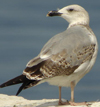 Yellow-legged Gull michahellis 2CY HES M016087 September 10 2007, Portalban, Switzerland. Picture: Stephane Aubry.
Yellow-legged Gull michahellis 2CY HES M016087 September 10 2007, Portalban, Switzerland. Picture: Stephane Aubry. Yellow-legged Gull michahellis 2CY-3CY ISTN 2005-2006, Switzerland. Picture: Stephane Aubry.
Yellow-legged Gull michahellis 2CY-3CY ISTN 2005-2006, Switzerland. Picture: Stephane Aubry. Yellow-legged Gull michahellis 1CY-2CY I233 November 2005 - September 2006, Switzerland. Picture: Stephane Aubry.
Yellow-legged Gull michahellis 1CY-2CY I233 November 2005 - September 2006, Switzerland. Picture: Stephane Aubry.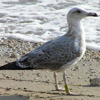 Yellow-legged Gull michahellis 2CY S6HK September 28 2008, Crikvenica, Croatia (45.11 N 14.42 E).
Picture: D. Barbalić.
Yellow-legged Gull michahellis 2CY S6HK September 28 2008, Crikvenica, Croatia (45.11 N 14.42 E).
Picture: D. Barbalić.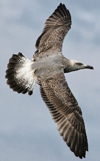 Yellow-legged
Gull michahellis 2CY, September 12 2012, Sant Carles de la Rapita - Ebro Delta, Cataluna, Spain. Picture: Chris Gibbins.
Yellow-legged
Gull michahellis 2CY, September 12 2012, Sant Carles de la Rapita - Ebro Delta, Cataluna, Spain. Picture: Chris Gibbins. Yellow-legged Gull michahellis 2CY, September 02 2010, Eforie Sud, Romania. Picture: Cristian Mihai.
Yellow-legged Gull michahellis 2CY, September 02 2010, Eforie Sud, Romania. Picture: Cristian Mihai.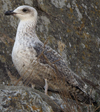 Yellow-legged
Gull lusitanius 2CY, September 07 2013, Peniche, Portugal. Photo: Hugo Albuquerque.
Yellow-legged
Gull lusitanius 2CY, September 07 2013, Peniche, Portugal. Photo: Hugo Albuquerque. Yellow-legged
Gull michahellis 2CY, September 21 2002, Etaples,
France.
Yellow-legged
Gull michahellis 2CY, September 21 2002, Etaples,
France. Yellow-legged
Gull michahellis 2CY, September 21 2002, Dannes -
Le Portel, France.
Yellow-legged
Gull michahellis 2CY, September 21 2002, Dannes -
Le Portel, France. Yellow-legged
Gull michahellis 2CY, September 22 2002, Etaples,
France.
Yellow-legged
Gull michahellis 2CY, September 22 2002, Etaples,
France.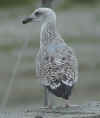 Yellow-legged
Gull michahellis 2CY, September 22 2002, Etaples,
France.
Yellow-legged
Gull michahellis 2CY, September 22 2002, Etaples,
France. Yellow-legged
Gull michahellis 2CY, September 30 2001, Dannes -
Le Portel, France.
Yellow-legged
Gull michahellis 2CY, September 30 2001, Dannes -
Le Portel, France. Yellow-legged
Gull michahellis 2CY, September 30 2001,
Boulogne-sur-Mer, France.
Yellow-legged
Gull michahellis 2CY, September 30 2001,
Boulogne-sur-Mer, France.
